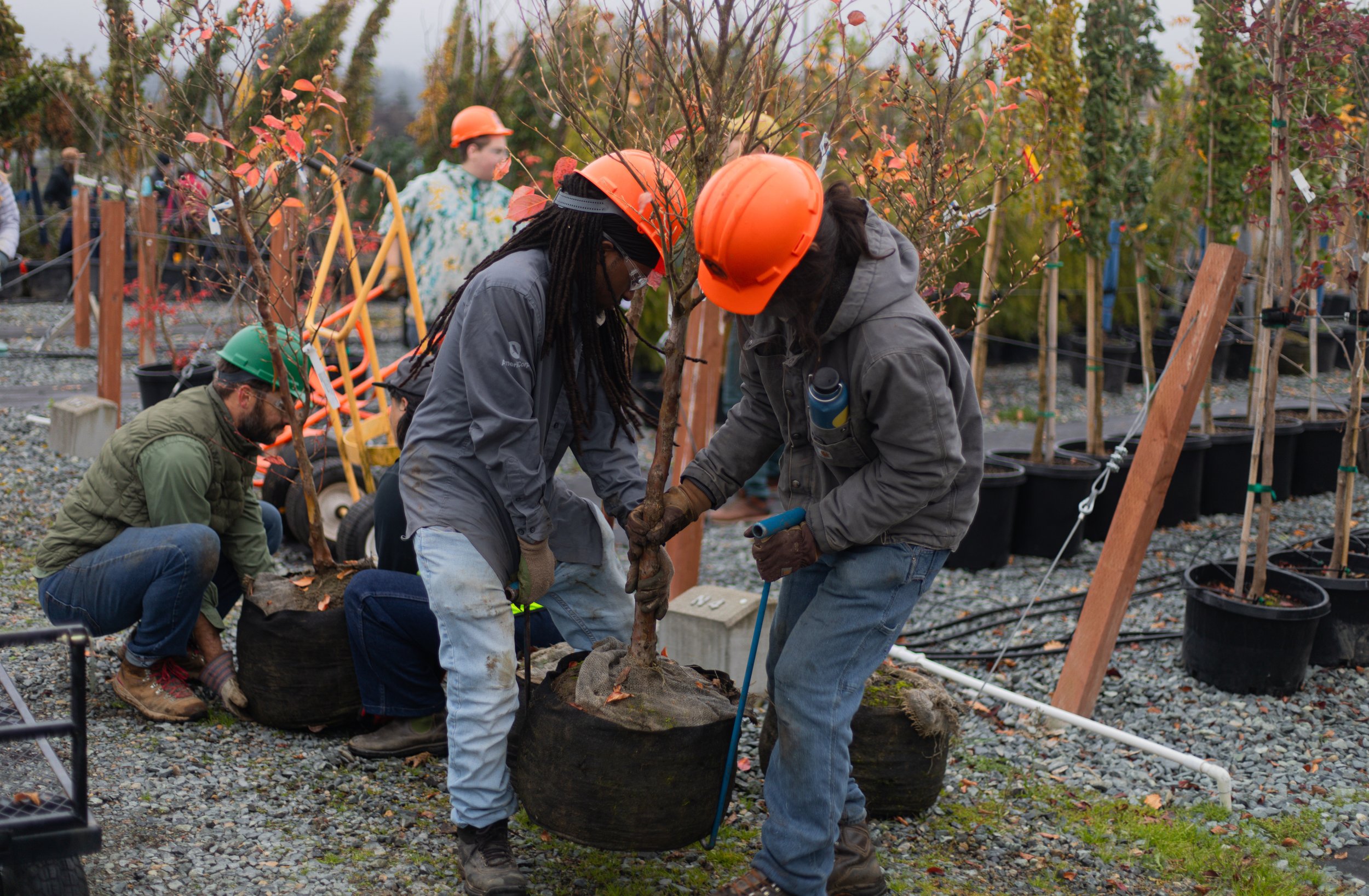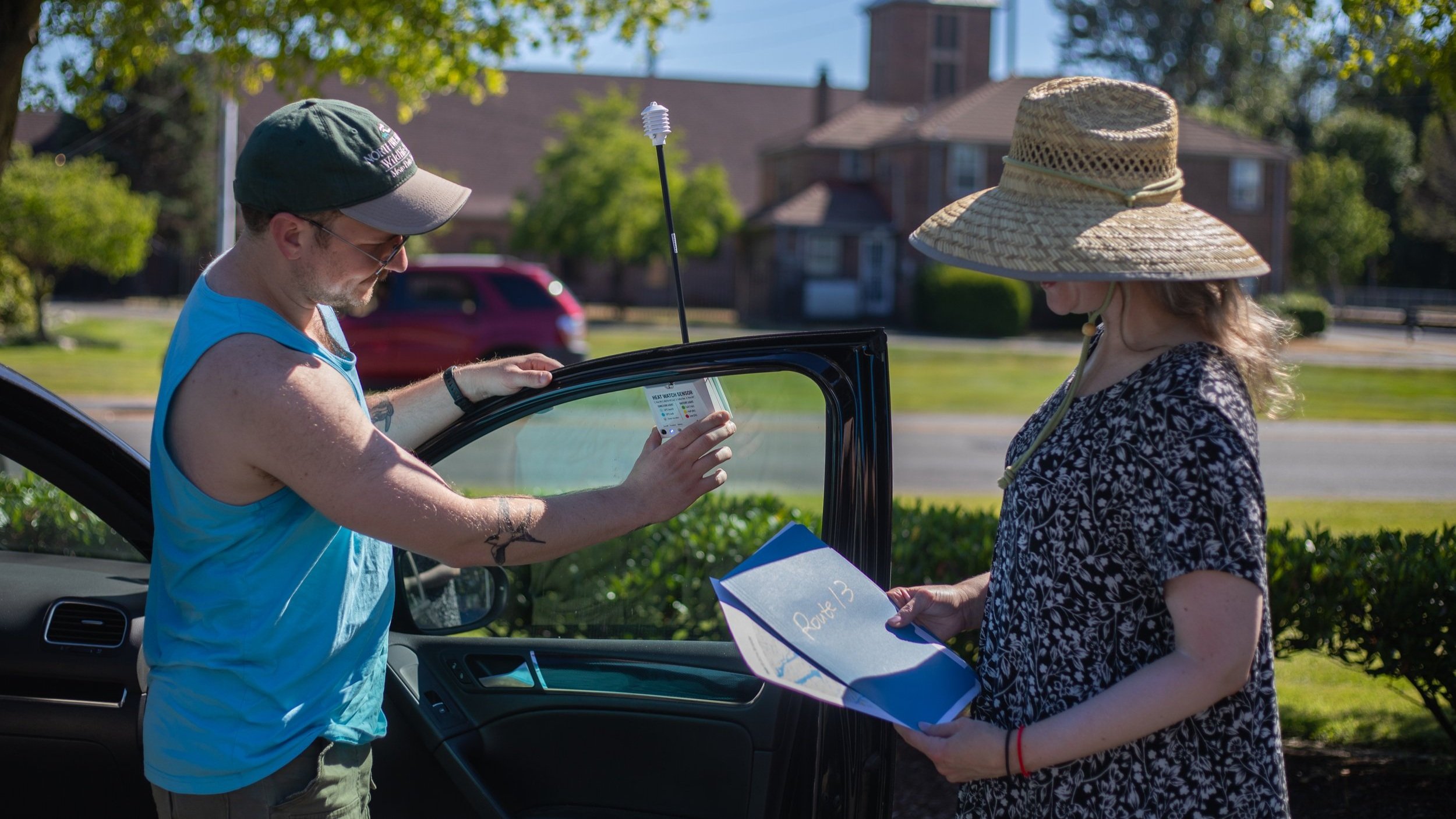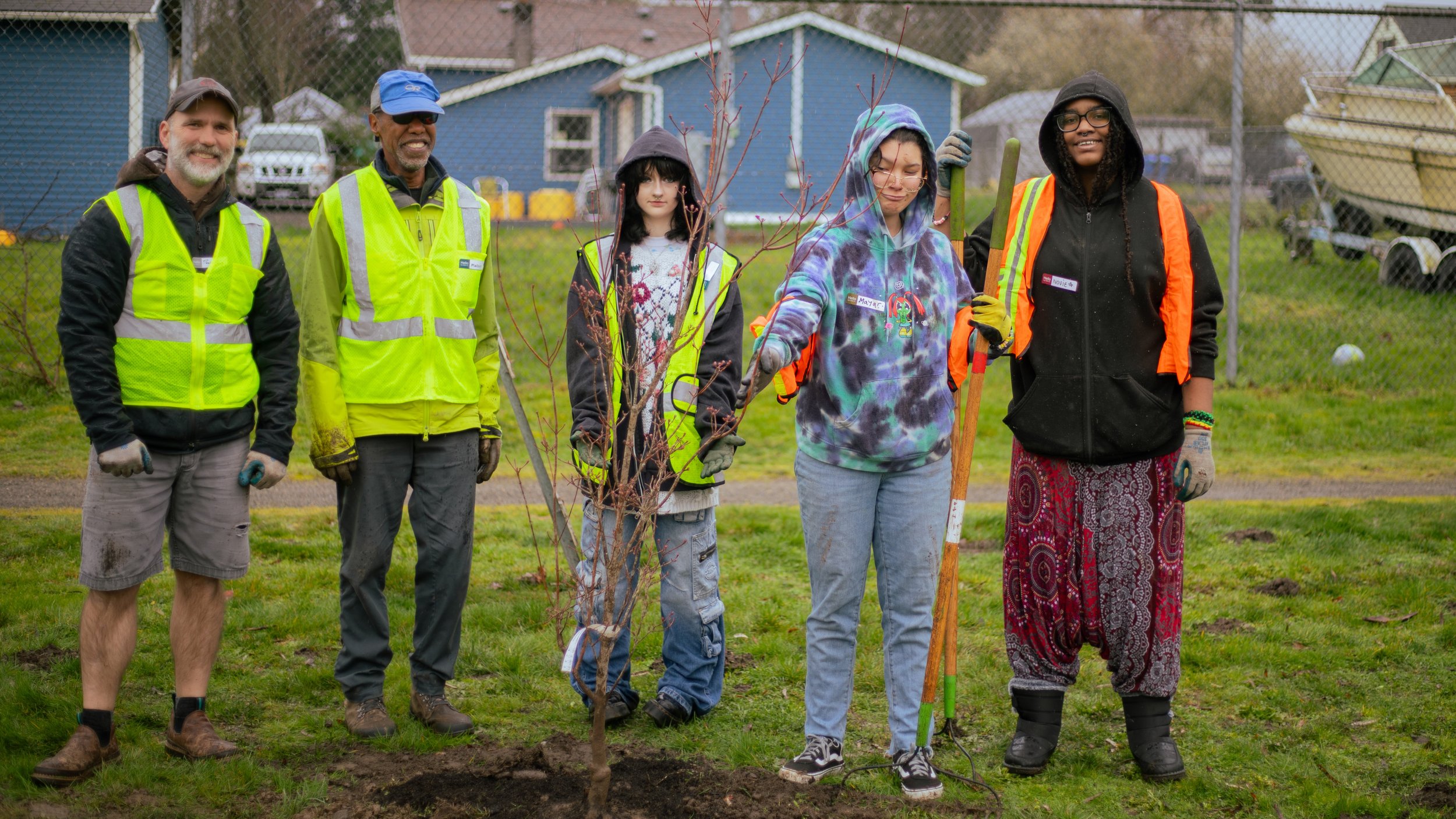2024: A YEAR OF GROWTH
"Driving through our neighborhood now, you can really see how the tree program has created this beautiful, cohesive feel to our streets. It's become a shared source of pride [...] I notice how each block's trees are maturing together, and I look forward to driving down these streets 20 years from now when they've all grown into a connected canopy. The program really is more than just trees and environmental sustainability; it's created this wonderful sense of shared stewardship in our community. Thank you for the work you do!"
- Lauren Angelo, Tree Recipient (Green Blocks: Lincoln)
Growing canopy, connecting neighbors
For the past six years, with every planting, education, and advocacy project, we have set out to increase access to trees and their benefits. We have done so not only for the ways trees sustain our watersheds and wildlife, but also for how they sustain communities.
This year, the neighbors we served shared with us that they see the connection between trees and people: tree recipients are experiencing a “sense of shared stewardship,” evidence that we are successfully working toward our vision to grow healthy, vibrant, and cohesive communities. This, in and of itself, is a huge accomplishment! And yet, it is the outcome of many other accomplishments we’ve celebrated.
Trees teach us that growth requires a developed web of relationships. In 2024, we grew our full-time team, our operations, our volunteer base, and our donor network. In the process, we actually reached our tree planting goal midway through the year, surpassing our wildest expectations!
Trees also teach us that growth involves adaptation and persistence. In this post, we are excited to share how your support allowed us to grow in 2024, and what we’ve learned along the way.
We provided more than 5,300 trees through a number of planting events and tree shares! 3,495 of these trees found homes in priority neighborhoods. Our goal for 2025 is to distribute 5,700 trees
Truck for Trees: Growing Our Operations
What does it take to share and plant trees? A village of partners and volunteers—and a truck! Bringing trees to planting events involves a chain of logistics: obtaining trees, caring for trees, loading and unloading, gathering volunteers and partners, mapping sites, and transporting tools and other necessary materials.
Until winter of 2024, we transported trees with our personal cars and partner vehicles, filling them up with saplings and other materials.
But we began the year with the purchase of a brand new electric truck, nicknamed “Cedro.” Its addition to our team has drastically improved our operations. The truck helped us to pull off 17 tree shares and planting events and set up our table at 38 events throughout the year.
During the hot summer months, we loaded Cedro up with a water bladder, watering the trees we have planted at local parks and schools, ensuring they grow healthy and resilient despite our changing climate.
Our budget also grew! When Lowell Wyse became Executive Director in 2021, our budget was $120,000. This year, it surpassed $500,000. Among many other things, this financial growth has allowed us to create new full-time positions, provide health and retirement benefits for our full-time staff, move into a more spacious office at the Union Club, and compensate our amazing part-time staff and guest speakers as they deserve.
Growing Canopy Block by Block
More efficient operations have allowed us to respond to the most exciting growth area of our work: demand for trees in Tacoma and Pierce County. We broke records in both our Green Blocks neighborhood-based programs and created a wealth of memories planting with partners in projects large and small.
We started the year with an inspiring planting in partnership with the Port of Tacoma, where a multigenerational team of 77 volunteers helped us plant 51 trees in the Tideflats, Tacoma’s lowest tree equity neighborhood. As spring began, we partnered with Pierce County Parks for the second Green Blocks: Parkland-Spanaway, where we shared 1,042 trees with 222 households.
With the Community Tree Program, we coordinated Green Blocks: Lincoln, sharing 288 trees with 150 households, and offering planting assistance for 81% of those trees. At Branch Out, we shared 274 trees with 103 households, with volunteers planting 65 of those trees for 18 households.
As we close out the year, we have reached a combined total of 475 households through our Green Blocks and Branch Out programs, not counting all those we reached through our 14 small-scale tree shares!
Why do residents want to grow their tree canopy?
Shade, beauty, and proximity to nature are the most commonly cited reasons on our tree request forms. When given a chance to explain how these core ecological services impact their daily lives, residents share amazing insights about the interconnections between trees and socioeconomic equity, health, and climate resilience.
“It's evident that wealthier and predominantly white areas benefit from significantly more green space, which contributes to their overall well-being. In contrast, South 34th Street is notably lacking in tree canopy. I believe that increasing the number of trees in our neighborhood could greatly enhance our quality of life and health.” - Luis Albizo, Tree Recipient (Green Blocks: Lincoln)
“Many trees have been cut down in my neighborhood. Our hope is to provide more nature, shade and more opportunities for neighbors to come together. We currently have a cherry tree, and it has brought many people to our door asking to pick cherries, inquire about the lights on the tree or just to admire. We would like to continue to foster the community the tree has brought us, as well as an opportunity to incorporate more nature into the neighborhood.” - Merac Crawford, Tree Recipient (Green Blocks: Lincoln)
Growing our capacity and partnerships has allowed us to deepen our commitment to priority neighborhoods, and BIPOC and multilingual residents, while still serving residents in higher tree equity neighborhoods.
For the second year in a row, and thanks to our partnership with the Community Tree Program, we provided language assistance at Branch Out. A team of six Language Ambassador partners, rooted in diverse communities, supported tree recipients in Korean, Spanish, Russian, Vietnamese, and Ukrainian. Offering language assistance has brought many new participants to the program and shows the importance of language access for connecting people with trees in Tacoma.
“Every time I volunteer with TTF, I feel a sense of belonging and purpose that is really empowering. This time around, I was inspired by how many different languages I heard during the Branch Out event - I hadn't realized just how busy our interpreters would be!”
-Branch Out Volunteer
Bringing these critical benefits to neighborhoods in Tacoma and Pierce County is possible thanks to strong local partnerships. This year, we also teamed up with the Northwest Youth Corps, a group of nimble, energized, and talented young people who have helped us with nursery care, planting, tree transportation, and community engagement in the busiest months. We have loved working with them, and are excited to continue to do so, especially because so many of the trees we plant are for them and future generations!
We’re grateful as well for the many organizations who have asked us to partner in tree shares and small-scale planting events, such as Chief Leschi Schools, Mi Centro, and Tacoma Community College.
These partnerships communicate trust in our team, which includes our part-time staff and our amazing volunteers. TTF volunteers are: neighbors who pot, plant, and table with us; Tree Captains, who lead volunteer teams during our biggest planting events; and Tree Stewards, who learn about tree planting, care, and health and take this knowledge back to their neighborhoods.
“I learned so much! I'd never planted a tree before, and the process was explained thoroughly several times. I feel confident that I could plant a tree on my own now. I also loved getting to meet new people that I actually ran into just days later at another community meeting space. I felt more deeply connected to Tacoma than before volunteering with you all!”
- Green Blocks: Lincoln Volunteer
Our volunteer base grew and its members donated 2,000 hours of time. That is 500 more hours than last year!
We trained 27 new Tree Stewards, and we’re 15 Tree Captains strong!
Community trust has also manifested in how important local organizations have relied on us to support meaningful projects that serve priority neighborhoods. A particularly exciting example is the Hilltop Urban Gardens (HUG) Wellness & Ecology Park. This park is meant to serve Black and systematically disadvantaged families and individuals by providing access to a safe green space, fruit, and shade. To this end, we supported by planting 15 trees, as well as berry shrubs. We’ve been excited to see the trees are thriving and growing, already changing the landscape and helping us envision the many ways this park will care for HUG and its supporters.
Growing Healthy and Resilient Communities
We also participated in research projects that support efforts to mitigate the worst effects of rapid development and climate change.
To this end, in the summer of 2024, we supported Pierce County’s heat mapping project. Aware of the Tacoma Tree Foundation’s passion for outreach and strong volunteer base, they entrusted us with volunteer recruitment, training, and event coordination. More than 100 volunteers signed up!
On August 4th, 32 volunteers spent the day driving the 16 different routes, at 6am, 3pm, and 7pm.
The data collected through the Heat Map project has highlighted that, on the hottest summer days, some neighborhoods can be up to 14 degrees hotter than others. The data also highlights that, with the exception of Point Defiance Park and Gig Harbor, Pierce County is so hot right now.
Trees are part of the long-term solution to the urban heat island effect. We will be using this information to continue identifying priority neighborhoods where we can support residents through planting, education, and advocacy.
Being entrusted with this work and breaking records in tree distribution is incredibly gratifying. But we are well aware that the work of keeping Pierce County climate resilient will only succeed if education efforts expand alongside our tree distribution and planting. The more opportunities we have to learn about tree care and to connect with trees, the more we can see the connections between trees, watersheds, wildlife, and each other.
This is why coordinating the Climate Leadership Cohort is one of the most important elements of our education program. We have offered this program in partnership with the City of Tacoma since 2022, and this year it grew to include Pierce County. For the Tacoma-Pierce County Climate Leadership Cohort training, we received 20 applications from a very diverse group of prospective leaders. Through a blind review process and prioritizing BIPOC and frontline community members, we were able to offer a spot to 15 climate leaders representing Bonney Lake, Gig Harbor, Lakewood, Spanaway, and East, Central, and South Tacoma.
“I enjoyed making connections with people throughout Washington, with people I’d probably never meet elsewhere. It’s good to see other people wanting to get involved and take charge of certain issues. The workshop was reassuring, seeing people working on issues, but also inspiring to also make bigger and better change.” -Climate Leadership Cohort Member ‘24
The class of 2024 met on May 23 and from May 30-June 2 to learn from elected officials, local advocates, and nonprofit leaders about the climate issues impacting our region. They spent the summer developing capstone projects in the areas of highest impact for their neighborhoods, and presented these projects on September 7 to an audience of peers, speakers, mentors, and loved ones.
Of the 15 Cohort members, 14 graduated, making it our most successful training yet! Their project topics included: civic engagement, climate change advocacy, and youth education; food accessibility and justice; heat, depaving, and regreening; and sustainable fashion. You can learn more about their projects on our blog.
With the support of a Tacoma Creates grant, we continued offering free educational programming that provides residents with ways of connecting with trees that range from urban forestry science to arts and crafts.
As part of our tree care programming we offered our very first fruit tree pruning workshop in partnership with UW-T’s Giving Garden and local tree expert and Master Gardener, Pamela Draper. Attendees included Tree Stewards who are taking advantage of our growing technical pruning workshops to build on their training and hone their knowledge and skills about specific tree care practices.
We also produced accessible video education on our social media and YouTube channels for the tree care and tree disease series. We partnered with Strategic Nature, our friends at Forest Health Watch—Joseph Hulbert, Fig Dewitz, and Zay Montejano—and Lisa Kenny, from the City of Tacoma’s Urban Forestry Program. We covered local tree diseases, such as sooty bark disease, and pests, such as the bronze birch borer, as well as providing free tips and tutorials on tree planting and year round tree care. Watch out for more in 2025!
We know that some of our most important educational event audience members are the youngest among us: it is for them that we are planting trees after all! With this in mind, we have continued to develop our youth education program, Nature Explorers, adding in-person presentations by collaborating with Greentrike, Tacoma Public Library, and when possible, local organizations, such as Peace Lutheran Church. These partnerships have allowed us to reach a new audience of parents and children, ages ranging from 0 to 16. We would especially like to thank Green Trike for helping us spread the word of our Nature Explorers online curriculum and zines, designed by Luna Azzouni, to highlight local flora and fauna and provide youth with inspiring ways to engage the nature around them.
“It has been heartening to see children bringing [the zines] to us during story time. Caregivers have mentioned they read the zines before bed or take them on outings to identify the creatures or plants featured in the materials. One caregiver even shared that their four-year-old gained confidence in reading as a result of "How Trees Talk to Soil," particularly enjoying the topic of trees. Many families have noted that these zines have sparked engaging conversations, leading to further collaborative research.”
-Jess Lam, Greentrike Play to Learn Program Coordinator
We concluded this year’s education program on a high note thanks to the 138 people who turned up for our biggest educational event of the year: State of the Urban Forest. On November 21, we gathered at UW-T’s Milgard Hall with the goal of informing Pierce County residents on the importance of Indigenous sovereignty and partnerships in urban forestry, the urgency of tree protections to Tacoma’s development projects, urban heat, climate resilience, and the life-saving and life-giving qualities of trees.
We were particularly inspired to meet new supporters, people who had never heard of us before, learned about the event online or at their local shops, and decided that they wanted to hear about trees and the future of the region.
Thanks to all of our sponsors and to everyone who joined our movement this November!
Total Education Programs: 74
Tree care and pruning workshops: 6
Tree art and culture: 6
Tree Science and Urban Forestry: 13
Climate Justice: 5
Mindfulness Walks: 7
Neighborhood Tree Walks: 8
Nature Explorer Curriculum: 4
Nature Explorer Presentations: 2
50% of our tree walks are bilingual.
Sustainable Growth
As this year’s overview shows, growing an urban forest that sustains all of us requires growing canopy with growing community. It also requires a healthy income that grows with the help of grants, sponsorships, and individual donations.
This year, we have been able to increase our income in surprising ways.
Some of our most successful planting and education programs are possible thanks to grants such as the Washington Urban and Community Forestry grant that allowed us to share trees and provide planting assistance in the Parkland-Spanaway neighborhoods. An American Forests grant allowed us to plant trees at Roosevelt Park and Wapato Hills Park. Small grants from the Puyallup Watershed Council grant, Chambers-Clover Creek Watershed Council grant, and the Key Peninsula-Gig Harbor grant allowed us to partner with local parks and organizations to distribute trees to residents.
We held our very first large scale in-person fundraiser, a themed breakfast that highlighted our mission to grow an urban forest for all. On the morning of April 17, 120 people gathered to hear an electrifying keynote by Yashar Vasef (Executive Director of Friends of Trees, Portland), which addressed the critical role of trees to support communities, individuals, and cities. New and longtime supporters rallied to help us raise $42,000 and grow new relationships, which are reflected in our volunteer and donor base. Growing our fundraising capabilities is key to supporting staff time and wellbeing. This year we did so–to great success!
We end 2024 drawing on what is perhaps the greatest lesson of the year: we have incredible community support. No matter what leaps and risks we took, you were with us, helping us reach for the tallest branch.
In 2025, we will continue to fulfill our vision for a future where neighbors help neighbors grow a greener, healthier, and more connected Greater Tacoma.
Thank you for being part of this movement!
Together We Grow the Future
Thank you to all of the partners, local institutions, organizations, and businesses who support our work. Some partners we collaborated with for our planting and education programs in 2024 are:
AMERICAN FORESTS, BLUE CACTUS PRESS, CITY OF TACOMA, GIRASOL COUNSELING, KING’S BOOKS, MI CENTRO, NORTHWEST YOUTH CORPS, FOREST HEALTH WATCH, GREENTRIKE, PIERCE COUNTY, PIERCE CONSERVATION DISTRICT, STRATEGIC NATURE, TACOMA-PIERCE COUNTY HEALTH DEPARTMENT, TACOMA PUBLIC LIBRARY, THE NATURE CONSERVANCY, UW-T, WINDZ OF CHANGE ALLIANCE
Many of these accomplishments have been featured in local news outlets.

















